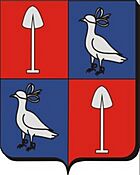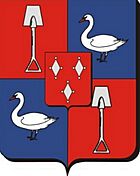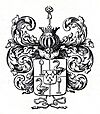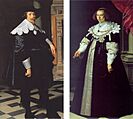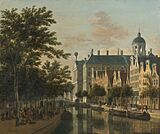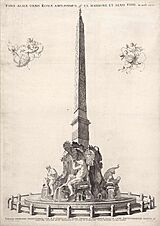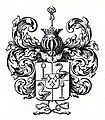Cornelis de Graeff facts for kids
Quick facts for kids Cornelis de Graeff van Polsbroek |
|
|---|---|
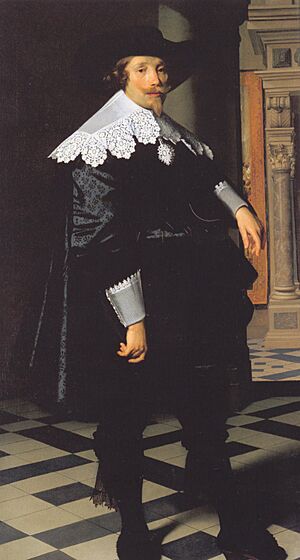
Portrait by Nicolaes Eliaszoon Pickenoy, (1636), Gemäldegalerie, Berlin
|
|
| Regent and Mayor of Amsterdam | |
| Reign | 1643–1664 |
| Predecessor | Andries Bicker |
| Successor | Andries de Graeff |
| President of the Dutch East Indies Company | |
| Reign | 1646–1664 |
| Predecessor | Andries Bicker |
| Successor | Pieter de Graeff |
| Born | 15 October 1599 House De Keyser, Amsterdam |
| Died | 30 January 1664 (aged 63) |
| Burial | Oude Kerk, Amsterdam |
| Spouse | 1) Geertruid Overlander van Purmerland 2) Catharina Hooft |
| Issue | Pieter de Graeff Jacob de Graeff Other relations Andries de Graeff (brother) Andries Bicker (cousin) Jan de Witt (nephew) Frans Banning Cocq (brother in law via Catharina) Pieter Corneliszoon Hooft (uncle) |
| House | De Graeff |
| Father | Jacob Dircksz de Graeff |
| Mother | Aeltje Boelens Loen |
Cornelis de Graeff (born October 15, 1599 – died May 4, 1664) was a very important person in Amsterdam during the Dutch Golden Age. He was often called Polsbroek or lord of Polsbroek because of a special title he held.
Cornelis de Graeff was a powerful regent (a ruler or governor) and burgomaster (mayor) of Amsterdam. He was also a statesman and diplomat for Holland and the Republic of the United Netherlands. His family, the De Graeff family, was one of the most powerful families in Amsterdam and Holland.
He was a strong supporter of the republican way of governing, which meant he believed the country should be run by elected officials, not by a single ruler like a king or prince. This was different from the Orangists, who supported the House of Orange (the royal family).
Cornelis de Graeff helped end the Eighty Years' War with Spain in 1648, which was a very important peace treaty. After the sudden death of stadholder (a kind of governor) William II of Orange, Cornelis de Graeff and his nephew, Grand pensionary Johan de Witt, became the main leaders of the republic. They worked together to keep Holland strong and free from a single ruler.
Cornelis de Graeff was known as a wise and skilled leader. He was respected by many people and tried to keep peace between different groups. He was also a patron of the arts, meaning he supported artists.
Family and Background
Family History
Cornelis de Graeff was the oldest son of Jacob Dircksz de Graeff, who was also a burgomaster of Amsterdam. His mother was Aeltje Boelens Loen. Her family, the Boelens Loen family, was one of the oldest and most important families in Amsterdam.
Cornelis's father believed in free thinking and republican ideas. He was also friends with William the Silent, a very famous leader of the House of Orange. This mix of ideas influenced young Cornelis.
The powerful families in Amsterdam were very close. Four of Cornelis's brothers and sisters married into the Bicker family, another very important family. For example, his sister Agneta de Graeff van Polsbroek married Jan Bicker. Their daughter, Wendela Bicker, later married Cornelis's nephew, Johan de Witt. Another daughter, Jacoba Bicker, married Cornelis's own son, Pieter de Graeff.
Cornelis was also related to famous people like the writer Pieter Corneliszoon Hooft and Frans Banning Cocq, who was the captain in Rembrandt's famous painting, The Night Watch.
Family Influence

The De Graeff family, along with the Bicker family, saw themselves as carrying on the legacy of the old Boelens family. They often married each other to keep their power and wealth strong. Their ancestor, Andries Boelens (1455-1519), was one of Amsterdam's most influential medieval mayors.
Family Symbols
Cornelis de Graeff had a special family symbol, called a coat of arms. It was divided into four parts.
- One part showed a silver shovel on a red background. This came from his father's side of the family.
- Another part showed a silver falcon on a blue background. This came from a property his family owned.
- His personal coat of arms also had a small shield in the middle. This shield showed three silver diamonds on a red background, representing his title as Lord of Zuid-Polsbroek.
- The motto on his coat of arms was: MORS SCEPTRA LIGONIBUS AEQUAT, which means "DEATH MAKES SCEPTERS AND HOES EQUAL." This reminds us that everyone, no matter how powerful, is equal in death.
Marriages and Children
In 1633, Cornelis de Graeff married Geertruid Overlander van Purmerland. She was the daughter of another burgomaster, Volkert Overlander. Sadly, Geertruid died just a few months later.
Cornelis then married Catharina Hooft, who was nineteen years younger than him. She was related to the famous poet P. C. Hooft. Cornelis and Catharina had two sons:
- Pieter de Graeff (1638-1707): He became Lord of Zuid-Polsbroek and was an important leader in the Dutch East India Company. He married his cousin, Jacoba Bicker.
- Jacob de Graeff (1642-1690): He helped lay the foundation stone for the new city hall in Amsterdam.
The family lived in a beautiful house on the Herengracht canal in Amsterdam.
Life and Political Work
Leading Amsterdam

Cornelis and his brother Andries de Graeff did not want the Orange family to have too much power. They wanted the individual regions of the Dutch Republic to be in charge, not a single ruler. They believed that the power should be with the States General (the government) and the city leaders.
During the time the De Graeff family led Amsterdam, the city was at its strongest. This period, from 1650 to 1672, was called the "Ware Vrijheid" (True Freedom) by the republicans. During these years, Amsterdam and Holland controlled the republic, and things went very well both politically and economically, even without a stadtholder.
Early Career
Cornelis de Graeff grew up near the Oude Kerk in Amsterdam. He had an accident as a child that left his left arm crippled.
In 1626, he went on a long trip through Europe with his younger brother. They visited cities like Paris and La Rochelle and met important people like Hugo Grotius.
Cornelis's career began in 1636 when he became a leader of the Dutch East India Company (VOC), a powerful trading company. In 1638, he took over his father's seat in the Amsterdam city council (Vroedschap) and became Lord of Zuid-Polsbroek.
In 1639, he became a Schepen (a type of judge or alderman) of Amsterdam and a captain of the city's citizen guard (schutterij). His company was even painted by the artist Jacob Adriaenszoon Backer. In 1643, Cornelis de Graeff became burgomaster (mayor) for the first time.
Big Political Moments
Building the City Hall
In 1648, Cornelis de Graeff helped start the building of the new city hall on the Dam Square, which is now the Royal Palace. This grand building was finished in 1655. It was designed to show the power and wealth of Amsterdam, much like the Doge's Palace in Venice.
Cornelis's son, Jacob de Graeff, helped lay the first stone of the building. The silver shovel he used is still in the Rijksmuseum in Amsterdam. A famous poet, Joost van den Vondel, even wrote a poem about this event, praising Cornelis de Graeff.
Peace and Power
Cornelis de Graeff was a key figure in making the Peace of Münster in 1648, which officially ended the Eighty Years' War. He also played a role in the Act of Seclusion in 1654, which tried to prevent William III of Orange from becoming stadtholder.
Cornelis de Graeff was very smart and could speak many languages, including Greek and Arabic. He supported famous artists and writers like Vondel and Jan Vos.
Cornelis de Graeff and Johan de Witt
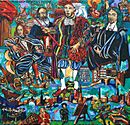
Cornelis de Graeff had a very important and close relationship with his nephew, Johan de Witt. De Witt was a very influential politician, and he often asked Cornelis for advice and support. Their relationship was strong, combining family ties with mutual respect.
In 1653, Cornelis de Graeff helped Johan de Witt become the "Grand Pensionary" of Holland, which was like being the chief minister. This partnership was very important for the republic.
Foreign Affairs
Amsterdam, under Cornelis de Graeff's leadership, was very powerful. In 1656, they sent a naval expedition under Michiel de Ruyter to the Mediterranean Sea. They also sent ships to the Baltic Sea during a war between Sweden and Poland, helping to keep the city of Danzig neutral.
Cornelis de Graeff was willing to take strong actions, even if it meant disagreeing with Johan de Witt. Despite their differences, they remained good friends.
William III's Education
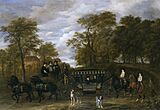
In 1660, the leaders of Holland, including Cornelis and his brother Andries de Graeff, decided to oversee the education of young William III of Orange. They wanted to make sure he would be prepared for a future role in the government.
The De Graeff family spent summers at Palace Soestdijk, where Cornelis's sons played with young William. William later became King of England, Scotland, and Ireland, and stadtholder of the Netherlands.
The Dutch Gift
In 1660, Cornelis and Andries de Graeff helped organize the "Dutch Gift" for King Charles II of England. This was a collection of 28 Italian Renaissance paintings, 12 classical sculptures, a yacht, and furniture. It was given to the King to celebrate his return to power after a period of exile.
The gift was meant to improve relations between England and the Dutch Republic. However, just a few years later, the two nations were at war again in the Second Anglo-Dutch War.
Death
Cornelis de Graeff died in 1664. His tomb is in the Oude Kerk in Amsterdam. After his death, his younger brother Andries took over his role in the city council. Johan de Witt also lost some of his influence in Amsterdam after Cornelis passed away.
Legacy
What People Said About Him
People said that Cornelis de Graeff was a fair and honest leader. He always looked out for the best interests of Amsterdam and all of Holland. He made sure that Amsterdam's power grew without isolating other towns.
Historians have noted that families like the Bickers and De Graeffs were like "uncrowned princes" in their time, holding immense power and wealth.
His Goals
Cornelis de Graeff's main goals were to strengthen Amsterdam's power within Holland and to increase the power of the Dutch Republic. He also wanted to limit the power of the House of Orange. He was known for being able to please Amsterdam while also considering the needs of other towns in Holland.
Images for kids




